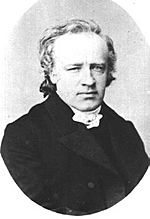Heinrich Louis d'Arrest facts for kids
Quick facts for kids
Heinrich Louis d'Arrest
|
|
|---|---|

Heinrich Louis d'Arrest
|
|
| Born | 13 August 1822 Berlin
|
| Died | 14 June 1875 (aged 52) |
| Nationality | German |
| Known for | Neptune |
| Awards | Gold Medal of the Royal Astronomical Society Lalande Prize (1844) |
| Scientific career | |
| Doctoral students | Thorvald N. Thiele |
Heinrich Louis d'Arrest (born August 13, 1822 – died June 14, 1875) was a German astronomer. He is best known for his important role in the discovery of the planet Neptune. He also found a comet, an asteroid, and several nebulae and galaxies.
Contents
Early Life and the Discovery of Neptune
Heinrich Louis d'Arrest was born in Berlin, Germany. Even while he was a student at the University of Berlin, he was involved in exciting astronomical research.
Helping to Find a New Planet
In 1846, d'Arrest joined Johann Gottfried Galle in the search for a new planet. This planet's location had been predicted by a scientist named Urbain Le Verrier. On September 23, 1846, d'Arrest had a brilliant idea. He suggested comparing a recently drawn map of the sky with the current view. They could look for anything that had moved, which would show it was a planet and not a fixed star.
Neptune's First Sighting
Thanks to d'Arrest's suggestion, the planet Neptune was discovered that very night! This was a huge moment in astronomy.
Discoveries in Space
After his work on Neptune, d'Arrest continued his studies at the Leipzig Observatory. He made many more important discoveries.
Finding Comets and Asteroids
In 1851, d'Arrest discovered a comet that was later named after him. It is officially known as 6P/d'Arrest. He also studied asteroids, which are small rocky bodies orbiting the Sun. He discovered the asteroid 76 Freia on October 21, 1862.
Exploring Nebulae and Galaxies
D'Arrest also spent time looking at nebulae and galaxies. Nebulae are giant clouds of dust and gas in space. Galaxies are huge collections of stars, gas, and dust. He discovered NGC 1 in 1861, and NGC 26 and NGC 358 in 1865. These are all objects listed in the New General Catalogue of nebulae and clusters.
Search for Martian Moons
In 1864, d'Arrest tried to find moons orbiting Mars. He didn't find any, but his work helped future astronomers. He figured out that if Mars had moons, they would likely be very close to the planet.
Awards and Legacy
Heinrich Louis d'Arrest was recognized for his important contributions to astronomy.
Prestigious Awards
In 1875, he received the Gold Medal of the Royal Astronomical Society. This is a very high honor for astronomers. He had also won the Lalande Prize in 1844.
Named After Him
To honor his work, several celestial bodies were named after him:
- The crater D'Arrest on the Moon.
- A crater also named D'Arrest on Phobos, one of Mars's moons.
- The asteroid 9133 d'Arrest.
Heinrich Louis d'Arrest passed away in Copenhagen, Denmark, in 1875.
See also
 In Spanish: Heinrich Louis d'Arrest para niños
In Spanish: Heinrich Louis d'Arrest para niños

